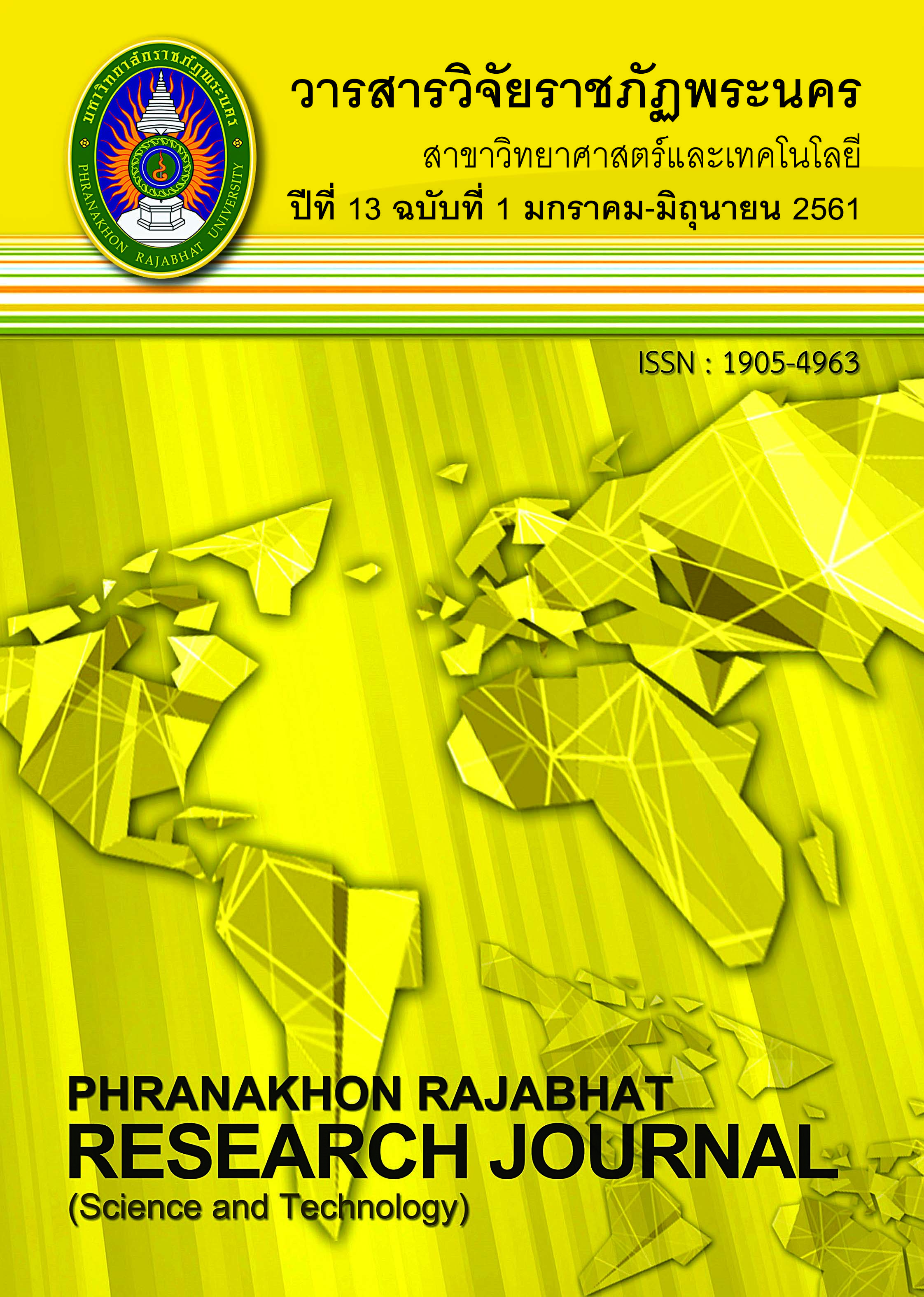EFFECT OF ADDITIONAL DRIED SESBANIA (SESBANIA JAVANICA MIQ.) FLOWERS POWDER ON PHYSICAL, NUTRITIONAL AND ORGANOLEPTIC CHARACTERISTICS OF BUTTER COOKIES
คำสำคัญ:
คุกกี้เนย, ผงดอกโสนอบแห้ง, เบต้า-แคโรทีน, ลักษณะทางกายภาพ, ลักษณะทาง ประสาทสัมผัสบทคัดย่อ
การวิจัยนี้มีวัตถุประสงค์เพื่อศึกษาลักษณะทางกายภาพ คุณค่าทางโภชนาการ และ ทางประสาทสัมผัสของคุกกี้เนยที่เติมด้วยผงดอกโสนอบแห้ง (DSFP) ในระดับที่แตกต่างกัน ซึ่งเป็นแหล่งของเส้นใย แคลเซียม และสารเบต้า-แคโรทีน คุกกี้ถูกเตรียมด้วย DSFP ใน 4 ระดับ ที่แตกต่างกัน (ร้อยละ 0, 3, 6 และ 9) และมีการประเมินลักษณะของสี ความแข็ง อัตราการ แผ่ขยายตัว คุณค่าทางโภชนาการ และทางประสาทสัมผัส การวัดค่าสี (ค่าความสว่าง (L*) ค่าความเป็นสีแดง (a*) และค่าความเป็นสีเหลือง (b*)) ของคุกกี้เนยด้วยเครื่องวัดสี พบว่าค่า L* และ a* มีค่าลดลง ในขณะที่ค่า b* มีค่าเพิ่มขึ้น เมื่อระดับของ DSFP เพิ่มขึ้นจากร้อยละ 0 ถึง 9 เมื่อพิจารณาคุณภาพด้านเนื้อสัมผัส พบว่าการผสม DSFP ในระดับที่เพิ่มขึ้นจากร้อยละ 0 ถึง 9 มีผลทำให้คุกกี้เนยมีความแข็งเพิ่มขึ้น อัตราการแผ่ขยายตัวของคุกกี้เนยสูตรควบคุมมีค่าสูงกว่า คุกกี้เนยที่ประกอบด้วย DSFP ร้อยละ 3, 6 และ 9 นอกจากนี้ยังพบว่าโปรตีน ไขมัน เส้นใย แคลเซียม และเบต้า-แคโรทีนมีปริมาณเพิ่มสูงขึ้น เมื่อผสม DSFP ในระดับที่เพิ่มขึ้น การประเมิน
ทางประสาทสัมผัส พบว่าคะแนนความชอบโดยรวมแตกต่างกันอย่างมีนัยสำคัญทางสถิติ (p<0.05) ระหว่างสูตรควบคุม และคุกกี้เนยที่ผสมด้วย DSFP โดยคุกกี้เนยที่ผสมด้วย DSFP ร้อยละ 3 ได้รับการยอมรับสูงสุด ดังนั้นจากผลการทดลองแสดงให้เห็นถึงความเป็นไปได้ ในการใช้ DSFP ในการเพิ่มคุณค่าทางโภชนาการของผลิตภัณฑ์คุกกี้เนย
เอกสารอ้างอิง
Kijparkorn, S., Plaimast, H. & Wangsoonoen, S. (2010). Sano (Sesbania javanica Miq.) flower as a pigment source in egg yolk of laying hens. Thai Journal of Veterinary Medicine. 40(3), 281-287. (in Thai)
Panichakornkul, W. (2016). Effects of drying temperatures on quality of dried Sernania flowers (Sesbania Javacica Miq) and it’s application in bread. VRU Research and Development Journal Science and Technology. 11(1), 47-55. (in Thai)
AOAC (2012). Official methods of analyses (17th Ed.). Washington DC: Association of Official Analytical Chemists.
Ames, B.N., Shigenaga, M.K. & Hagen, T. M. (1993). Oxidants, antioxidants, and the degenerative diseases of aging. Proceedings of the National Academy of Sciences of the United State of America. 90(17), 7915-7922.
Arshad, M.U., Anjum, F.M. & Zahoor, T. (2007). Nutritional assessment of cookies supplemented with defatted wheat germ. Food Chemistry. 102, 123-128.
Barak, S., Mudgil, D. & Khatkar, B. S. (2013). Effect of composition of gluten proteins and dough rheological properties on the cookie-making quality. British Food Journal. 115, 564-574.
Chauhan, A., Saxena, D.C. & Singh, S. (2015). Total dietary fibre and antioxidant activity of gluten free cookies made from raw and germinated amaranth (Amaranthus spp.) flour. LWT-Food Science and Technology. 63(2), 939-945.
Dachana, K. B., Rajiv, J., Indrani, D. & Prakash, J. (2010). Effect of dried Moringa (Moringa olefera Lam.) leaves on rheological, microstructural, nutritional, textural and organoleptic characteristics of cookies. Journal of Food Quality. 33, 660-677.
Drisya, C.R., Swetha, B.G., Velu, V., Indrani, D. & Singh, R.P (2015). Effect of dried Murraya koenigii leaves on nutritional, textural and organoleptic characeteristics of cookies. Journal of Food Science and Technology. 52(1), 500-506.
Dweyer, J., Navab, M., Dwyer, K., Hassan, K., Sun, P., Shircore, A., Hama-Levy, S., Hough, G., Wang, X. & Drake, T. (2001). Oxygenated carotenoid lutein and the progression of early atherosclerosis. Circulation. 103, 2922-2927.
Ingle, M., Ingle, M.P., Thorat, S.S., Nimbalkar, C.A. & Nawkar, R.R. (2017). Nutritional evaluation of cookies enriched with beetroot (Beta vulgaris L.) powder. International Journal of Current Microbiology and Applied Sciences. 6(3), 1888-1896.
Jan, R., Saxena, D.C. & Singh, S. (2016). Physico-chemical, textural, sensory and antioxidant characteristics of gluten-Free cookies made from raw and germinated Chenopodium (Chenopodium album) flour. LWT - Food Science and Technology. 71, 281-287.
Jeltema, M.A., Zabik, M.E. & Thiel, L.J. (1983). Prediction of cookie quality from dietary fiber components. Cereal Chemistry. 60, 227-230.
Kohlrneier, L. & Hastings, S.B. (1995). Epidemiologic evidence of a role of carotenoids in cardiovascular disease prevention. American Journal of Clinical Nutrition. 62, 1370S-6S.
McWatters, K. H. (1978). Cookie baking properties of defatted peanut, soybean and field pea flours. Cereal Chemistry. 55(6), 853-863.
Mancebo, C.M., Rodriguez, P. & Gomez, M. (2016). Assessing rice flour-starch-protein mixtures to produce gluten free sugar-snap cookies. LWT-Food Science and Technology. 67, 127-132.
Mudgil, D., Sheweta Barak, S. & Khatkar, B.S. (2017). Cookie texture, spread ratio and sensory acceptability of cookies as a function of soluble dietary fiber, baking time and different water levels. LWT-Food Science and Technology. 80, 537-542.
Nishia, K., Muranakaa, A., Nishimotob, S., Kadotac, A. & Sugahara, T. (2012). Immunostimulatory effect of β-cryptoxanthin in vitro and in vivo. Journal of Functional Foods. 4, 618-625.
Palozza, P., Muzzalupo, R., Trombino, S., Valdannini, A. & Picci, N. (2006). Solubilization and stabilization of β-carotene in niosomes: delivery to cultured cells. Chemistry and Physics of Lipids. 139, 32-42.
Pareyt, B. & Delcour, J.A. (2008). The role of wheat flour constituents, sugar, and fat in low moisture cereal based products: a review on sugar-snap cookies. Critical Reviews in Food Science and Nutrition. 48, 824-839.
Purlis, E. & Salvadori, V.O. (2007). Bread browning kinetics during baking. Journal of Food Engineering. 80, 1107-1115.
Sanusi, R.A. & Adebiyi, A.E. (2009). Beta carotene content of commonly consumed foods and soups in nigeria. Pakistan Journal of Nutrition. 8(9), 1512-1516.
Sharma, P., Velu, V., Indrani, D. & Singh, R.P. (2013). Effect of dried guduchi (Tinospora cordifolia) leaf powder on rheological, organoleptic and nutritional characteristics of cookies. Food Research International. 50(2), 704-709.
Singh, J., Singh, N., Sharmab, T.R. & Saxena, S.K. (2003). Physicochemical, rheological and cookie making properties of corn and potato flours. Food Chemistry. 83, 387-393.
Snodderly, D.M. (1995). Evidence for protection against age-related macular degeneration by carotenoids and antioxidant vitamins. American Journal of Clinical Nutrition. 62, 1448S-61S.
Tangvarasittichai, S., Sriprang, N., Talabporn Harnroongroj, T. & Changbumrung, S. (2005). Antimutagenic activity of Sesbania javanica Miq. Flower DMSO extract and its major flavonoid glycoside. Southeast Asian Journal of Tropical Medicine and Public Health. 36(6), 1543-1551.
van Poppel, G. & Goldbohm, R.A. (1995). Epidemiologic evidence for β-carotene and cancer. American Journal of Clinical Nutrition. 62, 1393S-402S.
Ziegler, R.G., Colavito, E.A., Hartge, P., McAdams, M.J., Schoenberg, J.B., Mason, T.J. & Fraumeni, J.F. (1996). Importance of α-carotene, β-carotene, and other phytochemicals in the etiology of lung cancer. Journal of the National Cancer Institute. 88, 612-615.
Zilic, S., Kocadaglıc, T., Vancetovic, J. & Gokmen, V. (2016). Effects of baking conditions and dough formulations on phenolic compound stability, antioxidant capacity and color of cookies made from anthocyanin-rich corn flour. LWT-Food Science and Technology. 65, 597-603.
ดาวน์โหลด
เผยแพร่แล้ว
ฉบับ
ประเภทบทความ
สัญญาอนุญาต
โปรดกรอกเอกสารและลงนาม "หนังสือรับรองให้ตีพิมพ์บทความในวารสารวิจัยมหาวิทยาลัยราชภัฏพระนคร สาขาวิทยาศาสตร์และเทคโนโลยี" ก่อนการตีพิมพ์




